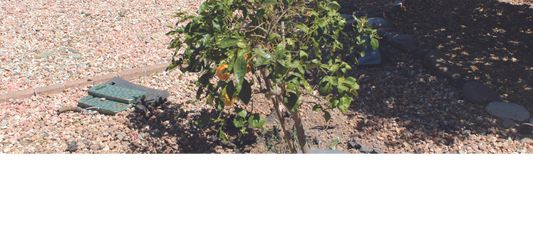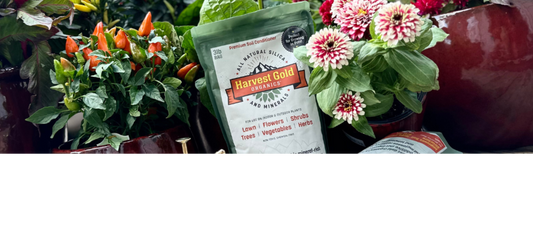What Are the Benefits of Silica for Plants?

In this article:
● What is the role of silica in plant growth?
● Which plants benefit the most from silica supplementation?
● How does silica benefit plants?
● Can silica be dangerous?
● How to apply silica to improve plant growth
● Silica for hydroponic growing
● Silica for soil-based growing
● How to add silica to soil for plant growth
Silica has been used for centuries in many different ways and forms. Some of the more common uses are in technology, construction, and agriculture. It is prevalent both in nature and man-made products.
What Is Silica?
How Is Silica Used?
Silica has become an incredibly useful material across many different industries, from technology to construction and even agriculture. By changing its shape to suit different purposes, it can be combined with other materials to give them new properties.
You’d be surprised by what silica is used in. It’s almost everywhere:
● Silica is used in multiple industries from construction to chemicals to glass and in common products such as paint, plastic, and rubber.
● Silica is a trace mineral integral to the structure and functional integrity of connective tissue, and it is a common health supplement that aids in the development of strong bones, skin, and nails.
● Silica absorbs moisture in everything from food packets to shoe boxes and dirty laundry to toolboxes.
What Is the Role of Silica in Plant Growth?
Plants can be categorized into three types in terms of their relation to silica.
Plants are classified into accumulators, excluders, and intermediate types, (Mitani and Ma, 2005) depending on the amount of biogenic silica found in their tissues.
Among the accumulators are Equisetales, Cyperales, and Poales. In Gramineae, rice is the highest silicifier: Si (in the form of biogenic silica, see below) accounts for up to 10% of the shoot dry weight (Ma et al., 2002).
Tomato is among the excluders. While the most significant benefits have been tied to accumulator plants, even non-accumulator plants like tomatoes have demonstrated positive responses to silica’s use in fertilization and growth medias. The most obvious benefits have been stronger stalks and pest and mold resistance, resulting in bigger plants and more fruit.
Urtica dioica (i.e., nettle) is an intermediate type (Trembath-Reichert et al., 2015) and has also demonstrated positive results with silica supplementation, but it is wise to take caution with supplementation. These plants are vulnerable to over-fertilization.
Many peer-reviewed, scientific studies have been done in recent years to determine the effects of silica on plant growth. Although silica is not one of the essential elements required for plant development, silica is categorized as a beneficial nutrient within the scientific community. These studies found several critical benefits from its inclusion.
Some of the benefits realized include:
● Increased resistance to abiotic stress, and external stressors like drought, wind, and heat.
● Increased resistance to biotic stress, and external living stressors like animals, bacteria, and fungi.
● The promising role of silica nanoparticles in plants
Silica Improves the Resistance to Abiotic Stress for Plants
Silica produces a complex reaction in the physiology of plants that creates a dynamic interplay between plant metabolism and cell wall structure.
In perfect conditions, the silica’s effect may be latent. However, with the introduction of an abiotic stressor such as drought, heat, or salt, the results are positive. Stronger stems help keep plants sturdy in wind and rain. Longer roots help to extract water from the soil while the epidermis of the leaves helps to retain some of the water loss that occurs during transpiration.
Silica seems to promote an alkalizing effect in metal-heavy soil, thereby decreasing the concentration in the soil.
This is partially because of the release of antioxidant enzymes that assuage oxidative stress. Leaves of plants with silica exposure also contain higher amounts of chlorophyll.
Bioavailable silica helps to reinforce the structural integrity of plant stems, roots, and leaves by strengthening the cell walls.
Silica Improves the Resistance to Biotic Stress in Plants
Silica creates a protective measure against animals, bacteria, and fungi in a couple of ways. One is that the composition of the plant itself becomes less palatable.
A second is that the molecular structure becomes less digestible. A third protective measure is the ability to ward off predators.
The Role of Nanoparticles in Plants
Sustainable agricultural models and food scarcity have long-standing importance, and silica nanoparticles may play an important role in solving these issues. Through a controlled release into the soil, silica nanoparticles and their counterparts combine to yield healthier, stronger, bigger plants.
In certain plants, this can affect germination, root growth, and chlorophyll levels. More research needs to be done in this area, but the current findings are promising.
Which Plants Benefit the Most from Silica Supplementation?
Recently industries such as cotton, sugar cane, and sod are recognizing the potential benefits of silica.
Recent research coming out of Australia demonstrates that crops such as rice, barley, oats, cotton, wheat, rye, sunflower, corn, sugar cane, potatoes, and forage crops all benefit from high levels of silicic acid in their cell tissues.
How Does Silica Benefit Plants?
- Improved Structural Integrity: Silica is taken up by plants and deposited in their cell walls, enhancing their structural integrity. This results in stronger, more robust plants that are able to withstand environmental stresses such as wind, rain, and pest pressure.
- Increased Disease Resistance: Silica helps plants defend against pathogens and pests. When deposited in the cell walls, it forms a physical barrier that makes it harder for fungi and insects to penetrate and infect plant tissues.
- Enhanced Drought Tolerance: Plants with sufficient silica levels are better equipped to handle drought conditions. The strengthened cell walls help retain water and reduce water loss through transpiration.
- Improved Nutrient Uptake: Silica facilitates the absorption of other essential nutrients, such as calcium and phosphorus. This can lead to overall healthier and more productive plants.
- Alleviation of Metal Toxicity: Silica can help plants tolerate higher levels of certain metals, such as aluminum and manganese, which can be toxic to plants in excess.
- Enhanced Photosynthesis: Silica aids in the process of photosynthesis by improving the structure of chloroplasts. This can lead to increased photosynthetic efficiency and ultimately higher yields.
- Resistance to Environmental Stresses: Silica-enriched plants are better able to withstand environmental stresses such as high salt content, extreme temperatures, and soils high in heavy metal contamination.
- Improved Crop Quality: Silica has been linked to better quality crops, including increased fruit and grain size, higher sugar content, higher terpenes, and improved resistance to lodging (the bending or breaking of plant stems).
- Longer Storage Life: Silica can help extend the post-harvest storage life of certain crops by reducing decay and deterioration.
Improved Nutritional Content: Some studies suggest that plants grown with sufficient silica levels may have higher levels of certain nutrients, which can translate to better nutritional content for humans and animals that consume these plants.
Can Silica Be Dangerous?
Silica can be harmful when turned into a very fine crystalline dust and inhaled.
Silica is generally harmless in its most common form and is even used as a health supplement and sold in pill form to strengthen brittle bones, teeth, nails, and hair.
Silica can be harmful when turned into a very fine crystalline dust and inhaled.
This may present a risk for people working in specific types of construction or manufacturing, but not gardening or farm management. In use as a silica fertilizer or growth medium, there is no danger from exposure or relating to its application. Products containing silica are to be treated as most other fertilizers and feeders.
How to Apply Silica to Improve Plant Growth
Silica is naturally occurring and therefore typically excellent for organic gardening; however, there are silicon supplements that are created in a lab. These lab-made supplements are chemically derived by combining Si (silica) with O2 (oxygen), creating SiO2, silicon dioxide, so if you’re keen to grow organically, you would want to consider a bioavailable silica made by nature.
It is worth noting that while silica is abundant in most soils, it may not always be in a plant-available form. There are two types of naturally occurring silica that are bioavailable to plants:
- There is amorphous silica derived from lava rock.
- There is bioavailable silica that comes from old mining sites.
Bioavailable silicon dioxide is especially powerful because it naturally encompasses veins of precious stones and metals like gold providing a broad range of minerals . Old mining sites have these tailings (mine waste) sitting on top of the ground, being washed by the rain, making the silica and other naturally occurring elements bioavailable with time.
Always remember, the specific benefits of silica can vary depending on the plant species, the growing conditions, and the presence of other nutrients.
Silica for Hydroponic Growing
Hydroponic growing is growing plants in water with no soil. Growers add plant essential nutrients through the water system and feed their plants with precision due to this method. The drawback is that nutrients get wasted with this method because the plant takes up nutrients at different times in its maturity, so it is key for the grower to know when beneficial nutrients are needed to support the plants in maturation.
Adding a solution-type silica would benefit hydroponic growing because there is no soil medium which aids in the growth of most plants.
Silica for Soil-Based Growing
The best way to introduce silica to your plants and crops is through a nutrient solution that will be delivered throughout the entire lifecycle of the plant. From seedling to final yield, plants need and will benefit from silica. By adding silica to soil-based crops, silica is always present to the plant at its root system.
It is common to increase the amount of nutrient solution as the plant matures, but be sure to read the product instructions and follow them accordingly.
How to Add Silica to Soil for Plant Growth
Harvest Gold Organics Premium Soil Conditioner is a unique silica aggregate that contains naturally occurring beneficial plant nutrients. The multifaceted soil amendment incorporates natural SiO2 (silicon dioxide) and eight plant essential elements, which, when watered, become bioavailable to surrounding plants.
This delivery method of silica and nutrients is unique in not only the initial delivery, but also its release over time, which amplifies plant growth throughout the entire season by providing a consistent release of micronutrients. When combined with a fertilizer, the angular shape of Harvest Gold Organics also helps to manage uptake and release of water and nutrients. Harvest Gold Organics allows you to reduce water and fertilizer by approximately 30%.
Harvest Gold Organics Premium Soil Conditioner is enriched with not only silica but also calcium, iron, sulfur, magnesium, and other micronutrients. It targets and maintains the nutrients vital to plant health in the area needed most: the roots. This results in bigger yields and less work. Perfect for organic gardening with flowers, vegetables, trees, and shrubs, Harvest Gold is USDA certified, certified for organic gardening by OMRI, and guarantees a high spectrum of nutrients. One application works all year round.
In Summary
Silica really is an amazing element that helps increase resistance to abiotic and biotic stress, resulting in stronger plants and plentiful harvests. Harvest Gold Organics Premium Soil Conditioner contains natural silica and eight plant essential elements necessary to grow big, strong plants, and tasty edibles without using harsh chemical fertilizers that cause damage to the environment and people.
Whether working on an indoor or outdoor project, using a non-toxic, chemical-free solution that feeds continuously without damaging the soil is beneficial to you and your plants.
You can buy Harvest Gold Organics Premium Soil Conditioner on our website, Amazon, Home Depot, Lowe’s, and many other retailers. If you have any questions, don’t hesitate to reach out. We would love to hear from you!



